Laughing Brook Wildlife Sanctuary
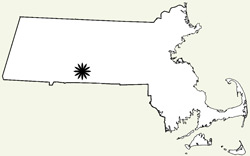
Location: Hampden, Massachusetts
Hours: Trails are open every day, dawn to dusk.
Access: The entrance to the sanctuary is just off of Main Street in Hampden, MA just before this road splits into Scantic and Glendale Roads. Driving Directions
Fees: Audubon members and Hampden residents, free; all others, $3 adults, $2 children and seniors (drop box payment system)
Activities: Hiking
Features: The 356 acre property includes building and land that once was the home of Thornton Burgess, a famous children's book author. Presently the property features four miles of hiking trails.
Habitats: meadow, stream, pond, wetland, forest
Rules and Regs:
• No off trail travel
• No smoking
• No picking or collecting plants
• No pets, on or off leash
• Picnic only in designated areas
• No bicycles or motorized vehicles
• No hunting, fishing or trapping
This Mass Audubon Sanctuary has an interesting conservation history. The home of Thornton Burgess is of course an important part of this property's history. Burgess wrote more than 170 books (Favorite Thornton Burgess Animal Stories) and 15000 stories for daily columns in newspapers. He created classic characters such as Old Mother West Wind and her Merry Little Breezes, Reddy Fox,, Johnny Chuck, Bobby Raccoon, and Jimmy Skunk. Thornton Burgess' books are entertaining but also teach children about nature. The author was a conservationist and that legacy also continues to live on ( http://www.thorntonburgess.org/index.htm ).
The original Burgess property was 18 acres in size. It was purchased by Audubon in 1966 and the property management has changed through the years. The sanctuary, which was originally called the Laughing Brook Nature Center, developed into a place to display wildlife for the public to view. These animals were set out in cages and enclosures along a nature trail and in one of the three buildings that were part of the original Burgess home buildings. Many animals displayed were once wild animals that were injured, then rehabilitated, but could not survive in the wild. Laughing Brook was visited by many people that lived in the local area and many nature programs for school children were taught through Laughing Brook programs (see the 1997 property report to the town of Hampden that is provided at the end of this webpage).
The educational aspect of the property eventually led to creating a sizable nature center. This effort was a continuation of Thornton Burgess' wishes, as he had originally willed his land to the town to use as a nature reserve and for teaching about nature and animals. Unfortunately careful demographics and population studies were not carried out and the center was, for its size and staffing, underutilized. The nature center was eventually closed and the building removed. The nature programs and teaching are largely gone. The property today is a wildlife sanctuary with hiking trails. The Burgess buildings remain but are typically not open to the public.
The photo below shows the nature center, to the right and just above the parking area, which is now gone. Two of the Burgess buildings can also be seen along the north (top) side of the road that runs from left to right (Main Street).
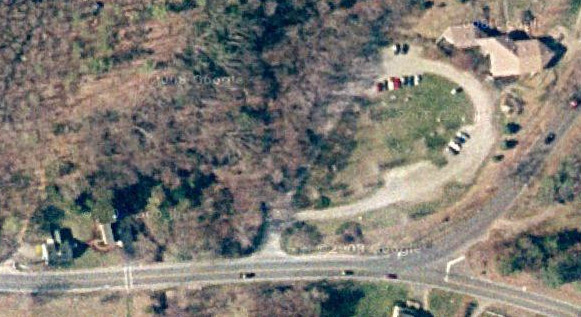
A Field Report from Laughing Brook
I visited Laughing Brook in August of 2009. The property is easy to find. The entrance is marked by a conspicuous sign and is gated. The parking lot only had a few cars when we arrived (a Wednesday afternoon).
We walked past the entrance signs that offered an introduction to the property, the fee drop box and a pamphlet with a map of the property. This spot, just beyond the signs, is where the nature center once was. We moved through that area and the small open meadow. The trail wound around and led to a covered platform that looked out over a pond. Moving beyond that we were quickly in a forest that was bordered by a stream.
The woods were damp, as it was a wet summer, and there was a profusion of fungi. Lots of mushrooms, chicken-of-the-woods and other fungal forms. The trail meandered through mixed hardwoods forest and some areas that were dominated by pine. This same pattern of passing from one forest type into another was to continue throughout all of the trails we walked at Laughing Brook.
The trail we had been on, the Mort and Helen Bates Trail, eventually gave way to the East Brook Trail. Along the way we passed by an interesting vernal pool. The trail then turned, at a rock wall, from its more northerly direction to a westerly heading. Here there was a rock wall and a wonderfully wolf tree. In fact there were many large trees on this property, more so than in many other areas where I have been that also have rocks walls and wolf trees. We passed by continuing down the East Brook Trail to hop onto the Burgess Trail, then took the Neff Loop Trail.
The Neff Loop was higher and had some different forest types than those found along the other trails. The size of the different habitat patches were larger too. Once around the Neff Loop we proceeded to finish off our walk by taking the remaining stretch of the Burgess Trail.
Laughing Brook Maps and Photos
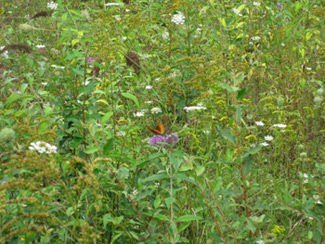
This meadow, just off the parking lot, was full of flowers and butterflies.
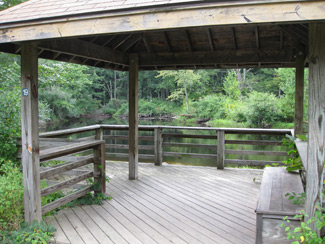
A viewing platform looked out over a small pond.
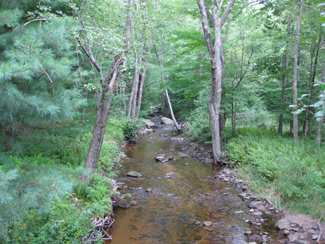
This is the stream that flows along the eastern boundary of the wildlife sanctuary.
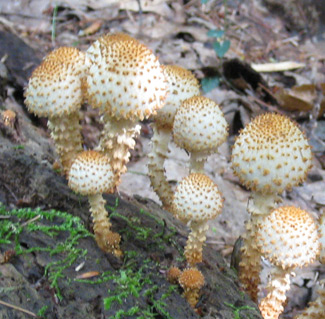
One of the many different kinds of fungi we encountered.
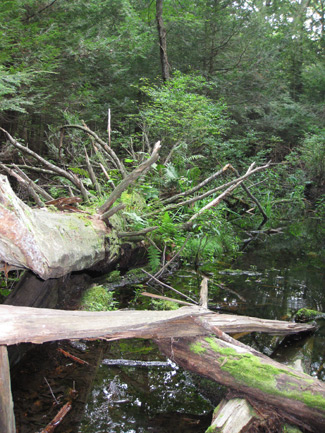
We came across the vernal pool along the East Brook Trail.
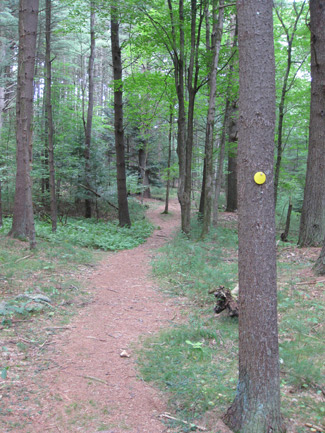
This was a portion of the Burgess Trail, along the section connecting the East Brook Trail and Neff Loop Trail.
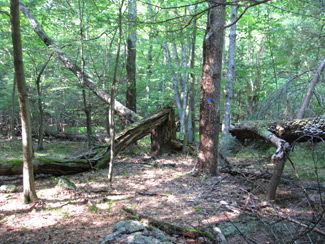
A view along the Neff Trail.
A report from Laughing Brook, as excerpted from the 1997 Hampden Town Report
Established in 1968, Laughing Brook is a part of the Massachusetts Audubon Society's statewide system of wildlife sanctuaries and field offices; as such, it serves the Greater Springfield area, The sanctuary protects 354 acres of southern New England forest, meadow, and wetlands in the Scanlic River watershed. As one of the Society's education centers, Laughing Brook is widely respected for the diversity and quality of its natural history and environmental education programs which are enjoyed by children, families, adults, school classes, and community groups. Four miles of comfortable walking trails, a variety of state-listed species, and the former home of children's author and naturalist Thornton W. Burgess are all found on the sanctuary and make Laughing Brook a special place to go birding, enjoy wildflowers, listen to the sounds of a woodland stream, participate in a program, observe wildlife in winter, do nature photography, assist with ecological studies, or serve as a volunteer at any time of the year.
Laughing Brook: The Wildlife Sanctuary
Approximately 3,000 visitors came to Laughing Brook this past year, not to participate in a program, but just to enjoy the natural beauty and observe the wildlife found in this very special place.
In order to better understand the status of our sanctuary's plants and animals, staff, volunteers, and program participants conducted a number of ecological inventory and monitoring activities this past year, including butterfly, dragonfly, and summer wildflower surveys.
As a part of our Natural History Day Camp "Adventurers" program, youngsters tested the water quality of Laughing Brook and the Scantic River by checking on pH and dissolved oxygen levels, as well as by the variety of aquatic macro-invertebrates present.
Laughing Brook has always been known for its populations of woodland warblers and thrushes, and this past June and July, the area around the Education Center was inundated with the flute-life songs of veeries maintaining their breeding territories; ovenbirds accomplished the same task along Laughing Brook. Earlier in May, the trilling of male American toads hoping to attract female toads filled the air by Smiling Pool, while in August dragonflies hovered near the pond's edge, vigorously defending their territories. In the fall, our late summer wildflowers hosted quite a show of Monarch and tiger swallowtail butterflies, and a number of sanctuary visitors took the opportunity to photograph these beautiful insects. "Our turkey vultures have maintained their roosts along the sanctuary's glacial esker, and cedar waxwings regularly feed on the berry bushes planted by the parking lot.
As many people in the community know, the Burgess outbuildings have been deteriorating for a number of years, but Laughing Brook has lacked the funding to make repairs (a 1996 estimate placed the cost of their renovation at approximately $125,000). However, last spring we decided to see what the level of interest was in restoring them, and asked our membership to make pledges as a symbol of their interest in this project. Unfortunately we only received two pledges totaling $260. Despite this, the Society decided to go ahead and "gut" the three buildings so that a more accurate renovation estimate could be determined. As of December 31st , the three buildings are almost ready for contractors to come in and submit bids, and the Burgess barn studio has already received a new roof and foundation (due to conditions created by the April 1st storm and an old tree), courtesy of the Society's emergency capital funding program. We hope community residents will indicate their interest in this project by contributing pledges of financial support or in-kind services.
In 1998, we are looking forward to installing a new trail sign system and having a new sanctuary trail map and brochure. We've made a few changes in the names, so that visitors can once more walk down the Crooked Little Path, the Green Forest and Storyteller's Trails, and the Jimmy Skunk Loop!
Laughing Brook: The Education Center
During the past twelve months at "Laughing Brook, the Education Center":
• 169 public natural history programs were run with a total of 1,785 participants;
• 18 outreach programs were presented to various community groups and reached 824 people;
• 47 school programs were held on sanctuary, and 121 school programs were conducted at schoolyards and parks; the audience total for these programs was 3,830 curious children;
• 85 teacher workshops (now called professional development opportunities) were held with a total of 1,119 enthusiastic educators participating;
• 225 children attended our Natural History Day Camp in July and August and enjoyed the sanctuary and all of the learning opportunities it represents.
The Massachusetts Board of Higher Education awarded a Dwight D. Eisenhower Professional Development Grant to Laughing Brook in both the 1997 and 1998 fiscal years. These grants allowed us to work with over fifty teachers throughout both the 1996-1997 and 1997-98 school years, teaching them how to conduct meaningful nature study activities while carrying out their science and mathematics curriculums. Elms College is our higher education planner in this endeavor.
Children ages 3-1/2 to 5 years of age have continued to enjoy Laughing Brook's "Little People's Adventures" program. The youngsters play nature-oriented games, make crafts, and explore the sanctuary in search of seasonal phenomena and signs of wildlife.
Laughing Brook received its fifth year of funding from the Massachusetts Department of Education and the Hampden Wilbraham Regional School District for serving as the Museum Planner in the state's PALMS (Partnerships Advancing the Learning of Mathematics and Science) project in the 1997-98 school year. Our "PALMS Family Nights" have permitted local parents and children to sample the state's new approaches to mathematics and science education.
The Bay State Gas Company funded a "Naturalist in Residence" program last spring at Dorman School in Springfield. This innovative program brought a Laughing Brook educator into a school to work with teachers and students in carrying out their required curriculum through the medium of school yard nature activities. Our work with the Springfield Public Schools also included presenting seven days of professional development for their teachers, and beginning our founh year of "Neighborhood Nature" (Neighborhood Nature is a four-pan sixth grade program that deals with urban wildlife and environmental issues).
During 1997, we were pleased to continue our work with the Pioneer Valley Girl Scout Council by offering several Girl Scout Badge Days on science and nature topics. We were especially pleased to receive a grant from The Irene E. and George A. Davis Foundation in December that will allow us to expand our work with both the girls and their leaders throughout the Greater Springfield area.
In the first two weeks of July, Laughing Brook once again had the opportunity to be a "museum planner" for the fifth year in a row with the Museum Institute for Teaching Science. We hosted thirty-five teachers over a two week period so that they could learn how to use the natural world to conduct scientific and mathematical experiments with their students.
This past fall, Laughing Brook began to present a graduate course entitled "Schoolyard Investigations" to teachers in the Ludlow Public Schools. As is true for many of our teacher workshops, the focus of this program was how to use schoolyard natural history to carry out the State's new mathematics and science program curriculum frameworks. Elms College is serving as our higher education planner with this program as well.
Respectfully submitted,
Douglas W Kimball, Sanctuary Director
More Public Land Journal field reports from Massachusetts public lands:
High Ledges Wildlife Sanctuary
Horesneck Beach State Reservation
Other Massachusetts outdoor resources
Find other Massachusetts Public Lands
- Land Unit:
- State:
- State Tag: